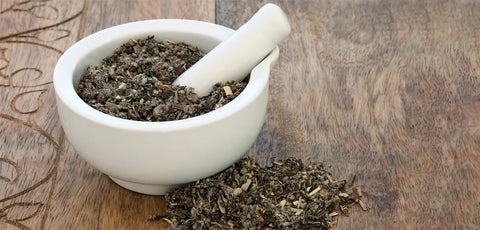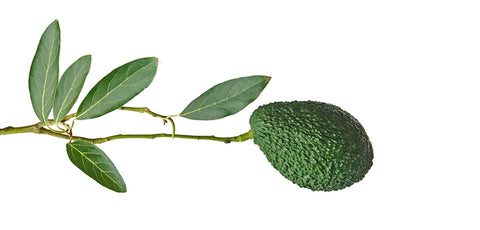Other Names: Altamisa, Armoise, Armoise Citronnelle, Armoise Commune, Armoise Vulgaire, Artémise, Artemisia, Artemisia Vulgaris, Artemisiae Vulgaris Herba, Artemisiae Vulgaris Radix, Carline Thistle, Felon Herb, Gemeiner Beifuss, Herbe aux Cent Goûts, Herbe de Feu, Herbe de la Saint-Jean, Herbe Royale, Hierba de San Juan, Nagadamni, Remise, Sailor’s Tobacco, St. John’s Plant, Tabac de Saint-Pierre, Wild Wormwood
Mugwort—or as we’ve categorized it, estafiate—is not a house at Hogwarts. In the past, mugwort was an appreciated weed. Roman soldiers put mugwort in their sandals before a long journey in order to ward off fatigue. Indigenous Peoples of North America used it to wash and treat bruises, itching, sores, poison ivy, eczema, and body odor. Today, while still used medicinally, it’s common to hear American gardeners complain about mugwort when they find it growing in their gardens. A relative to ragweed, mugwort is typically destroyed when found. In fact, it grows so rapidly that it’s illegal to plant in some states. While now considered an invasive garden weed, mugwort is still a sacred plant in the wellness and herbal community. Some even believe that it has mystical and magical attributes. In witchcraft tradition, it has long been used to induce lucid dreaming, to help with astral projection, and to enhance psychic abilities.
This dark green, leafy herb typically grows between 3 and 6 feet tall and has a pretty purple stem. Its botanical name is Artemisia vulgaris, and it’s a perennial member of the daisy family that is native to Asia, North America, and North Europe. It’s been used for centuries for everything from digestive disorders to beer-making, insect repellent, and more. We’ve rounded up the top 5 reported benefits of using mugwort and, as with all things herbal, please consult your physician before you incorporate mugwort into your wellness routine.
Enhanced Healing
Mugwort is commonly used in traditional Asian medicine during a process called moxibustion. Moxibustion is a therapy used with acupuncture. Practitioners form mugwort leaves into sticks or cones about the size and shape of a cigar and then burn on or over an acupuncture point to release toxic energy. Herbalists and medical practitioners alike have been using this therapy for over 3,000 years and claim it can strengthen the blood and life energy of the body.
Menstrual Stimulator
Mugwort is commonly used to stimulate a woman’s menstrual cycle. The chemicals in mugwort are thought to trigger contractions and help speed the progress of labor during childbirth. Historically, it’s been used to induce abortions as it’s thought to increase pelvis and uterus circulation. It has also been used to promote menstrual flow, remove stagnant blood (the source of cramps, stiffness, and pain) and regulate hormone levels. Women take it internally (tea, tincture) or apply it topically on their lower abdomen.
Nerve Calming
Mugwort is commonly used to regulate hormone secretions. People who have consumed it have reported emotional benefits such as a feeling of relaxation and calmness. Energy practitioners commonly use it during deep meditation, as it seems to soothe the brain, settle anxiety, and even help with depression. There are a variety of ways to consume it, including drinking it as tea, smoking it, and using a tincture.
Digestive Help
Mugwort is commonly used to improve digestion. It’s thought to help increase the production of gastric juice and bile secretion so that the digestive system is returned to a normal balance. The compounds in mugwort leaf help relieve constipation, diarrhea, bloating, indigestion, and other ailments associated with the digestive tract. It’s also a remedy to treat worms and intestinal parasites in both people and animals. World travelers often use mugwort preventatively for its antifungal and antibacterial benefits.
Insect Repellent
Mugwort is commonly used as the active ingredient in plant-based mosquito repellent, as it is safe to apply topically. In its original form, it inhibits other plants from growing and also repels insects. Gardners use the powdered form in moderation to prevent insect infestations and prevent the development of larvae. Since the European Middle Ages, people have used the herb to repel moths from their gardens. Most recently, a 2020 study supports the use of mugwort as a repellent for bed bugs.
The benefits don’t stop there. Mugwort is a weed that has many wonderful virtues. It has been used to treat headaches, epilepsy, colic, fatigue, and irritability, just to name a few. Prepared several ways, mugwort can be used in incenses, infused oils, smudging mixes, teas, and tinctures. It is composed of several therapeutic chemicals, including camphor, pinene, and cineole. However, other active components, such as thujone, can be toxic in excessive doses or under prolonged intake can cause liver damage, nausea, and convulsions. There is a lack of medical research data to determine a safe range of doses, so please consult your physician before adding mugwort to your wellness routine.
Mugwort is available in our store, in its natural herb form. Here at Evergreen Herbs, quality comes first—it’s both our motto and our customer commitment. All of our herbs are wild crafted and examined by a 3rd party certified lab that tests for heavy metals and microbiology trespassers. Learn more about our process here. Let us know in the comments: Do you take mugwort? What benefits have you experienced?




